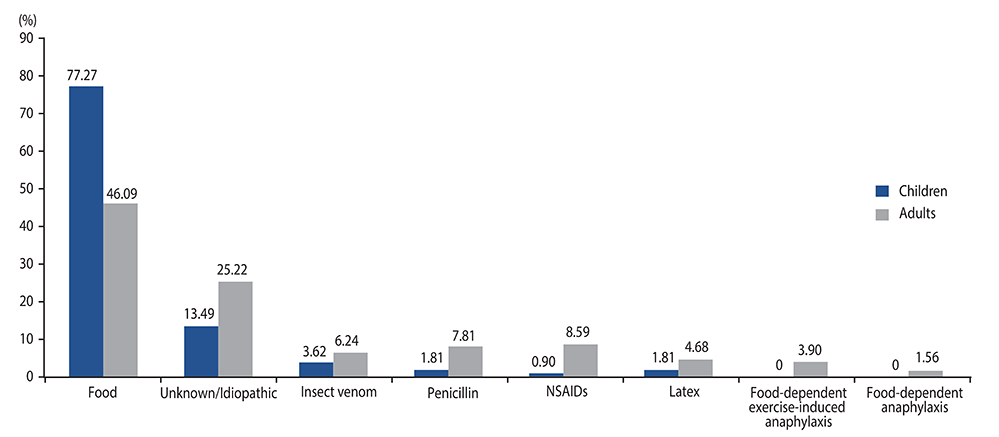Asia Pac Allergy.
2015 Oct;5(4):216-221. 10.5415/apallergy.2015.5.4.216.
First study of pattern of anaphylaxis in a large tertiary care hospital in Saudi Arabia
- Affiliations
-
- 1Section of Allergy & Immunology, Department of Medicine, King Faisal Specialist Hospital & Research Center, Riyadh 3354, Saudi Arabia. fsheikh96@kfshrc.edu.sa
- 2Medical and Critical Care Pharmacy, Department of Pharmaceutical Care, King Faisal Specialist Hospital & Research Center, Riyadh 3354, Saudi Arabia.
- 3Department of Medicine, King Faisal Specialist Hospital & Research Center, Riyadh 3354, Saudi Arabia.
- 4Department of Biostatistics, Epidemiology and Scientific Computing, King Faisal Specialist Hospital & Research Center, Riyadh 3354, Saudi Arabia.
- KMID: 2397038
- DOI: http://doi.org/10.5415/apallergy.2015.5.4.216
Abstract
- BACKGROUND
Anaphylaxis is a serious allergic reaction that may cause death. The signs and symptoms of anaphylaxis have not been examined in the Saudi population before.
OBJECTIVE
The present study examined the signs, symptoms, triggers, and demographic patterns of patients treated for anaphylaxis at a large tertiary care hospital in Riyadh, Saudi Arabia.
METHODS
All the patients who were prescribed new prescriptions of adrenaline auto-injectors (AAs) between February 1, 2010 and December 31, 2011 were included in this study. Information was collected using a standardized form.
RESULTS
There were 238 patients who were analyzed. The median age at the time of first AA prescription was 15.5 years. Female to male ratio was 52:48 and 54% of the subjects were more than 18 years of age. There were some differences in the presenting signs and symptoms observed in our study compared with similar studies from around the world. Urticaria and angioedema were the most common at about 70% across all ages, followed by shortness of breath at 28%. Some triggers were found to be more common in our region. Food was the commonest trigger for anaphylaxis including tree nuts, egg, and sesame. Drug allergy was also a common trigger, with penicillins and nonsteroidal anti-inflammatory drugs being the commonest. Regarding insect allergy, samsam ant was the commonest trigger in our study.
CONCLUSION
To our knowledge, this is the first study on anaphylaxis in Saudi Arabia. Some of the manifestations of anaphylaxis are significantly different in our population study compared to previously published data from other parts of the world. While managing anaphylaxis, we should be mindful of these differences. This improved understanding should help reduce the morbidity and mortality associated with anaphylaxis in our region.
Keyword
MeSH Terms
Figure
Cited by 1 articles
-
Great learning, much networking, and friendship
Yoon-Seok Chang
Asia Pac Allergy. 2015;5(4):191-192. doi: 10.5415/apallergy.2015.5.4.191.
Reference
-
1. Sampson HA, Munoz-Furlong A, Campbell RL, Adkinson NF Jr, Bock SA, Branum A, Brown SG, Camargo CA Jr, Cydulka R, Galli SJ, Gidudu J, Gruchalla RS, Harlor AD Jr, Hepner DL, Lewis LM, Lieberman PL, Metcalfe DD, OConnor R, Muraro A, Rudman A, Schmitt C, Scherrer D, Simons FE, Thomas S, Wood JP, Decker WW. Second symposium on the definition and management of anaphylaxis: summary report: Second National Institute of Allergy and Infectious Disease/Food Allergy and Anaphylaxis Network symposium. J Allergy Clin Immunol. 2006; 117:391–397.2. Lieberman P, Camargo CA Jr, Bohlke K, Jick H, Miller RL, Sheikh A, Simons FE. Epidemiology of anaphylaxis: findings of the American College of Allergy, Asthma and Immunology Epidemiology of Anaphylaxis Working Group. Ann Allergy Asthma Immunol. 2006; 97:596–602.
Article3. Golden DB. Patterns of anaphylaxis: acute and late phase features of allergic reactions. Novartis Found Symp. 2004; 257:101–110.
Article4. Liew WK, Williamson E, Tang ML. Anaphylaxis fatalities and admissions in Australia. J Allergy Clin Immunol. 2009; 123:434–442.
Article5. Ewan PW, Dugue P, Mirakian R, Dixon TA, Harper JN, Nasser SM. BSACI. BSACI guidelines for the investigation of suspected anaphylaxis during general anaesthesia. Clin Exp Allergy. 2010; 40:15–31.
Article6. Chacko T, Ledford D. Peri-anesthetic anaphylaxis. Immunol Allergy Clin North Am. 2007; 27:213–230.
Article7. Harboe T, Benson MD, Oi H, Softeland E, Bjorge L, Guttormsen AB. Cardiopulmonary distress during obstetrical anaesthesia: attempts to diagnose amniotic fluid embolism in a case series of suspected allergic anaphylaxis. Acta Anaesthesiol Scand. 2006; 50:324–330.
Article8. Ebo DG, Bosmans JL, Couttenye MM, Stevens WJ. Haemodialysisassociated anaphylactic and anaphylactoid reactions. Allergy. 2006; 61:211–220.
Article9. Pumphrey RS. Lessons for management of anaphylaxis from a study of fatal reactions. Clin Exp Allergy. 2000; 30:1144–1150.
Article10. Simons FE. First-aid treatment of anaphylaxis to food: focus on epinephrine. J Allergy Clin Immunol. 2004; 113:837–844.
Article11. Simons FE, Ardusso LR, Bilo MB, El-Gamal YM, Ledford DK, Ring J, Sanchez-Borges M, Senna GE, Sheikh A, Thong BY. World Allergy Organization. World Allergy Organization anaphylaxis guidelines: summary. J Allergy Clin Immunol. 2011; 127:587–593.e1-22.
Article12. Mullins RJ, Clark S, Camargo CA Jr. Regional variation in epinephrine autoinjector prescriptions in Australia: more evidence for the vitamin D-anaphylaxis hypothesis. Ann Allergy Asthma Immunol. 2009; 103:488–495.
Article13. Tham EH, Tay SY, Lim DL, Shek LP, Goh AE, Giam YC, Chng HH, Lee BW. Epinephrine auto-injector prescriptions as a reflection of the pattern of anaphylaxis in an Asian population. Allergy Asthma Proc. 2008; 29:211–215.
Article14. Handfield KS, Dolan CK, Kaplan M. Cholinergic urticaria with anaphylaxis: hazardous duty of a deployed US marine. Cutis. 2015; 95:241–243.
- Full Text Links
- Actions
-
Cited
- CITED
-
- Close
- Share
- Similar articles
-
- Seroprevalence of Helicobacter pylori Infection in Large Series of Patients in an Urban Area of Saudi Arabia
- Continuing medical education as a national strategy to improve access to primary care in Saudi Arabia
- Missense Mutations in the CTSC Gene in Saudi Families Segregating Papillon-Lefèvre Syndrome
- EEG spikes resembling cardiac M-shaped waves in the EKG: the cerebral M pattern
- A Laboratory-Based Study for First Documented Case of Urinary Myiasis Caused by Larvae of Megaselia scalaris (Diptera: Phoridae) in Saudi Arabia


